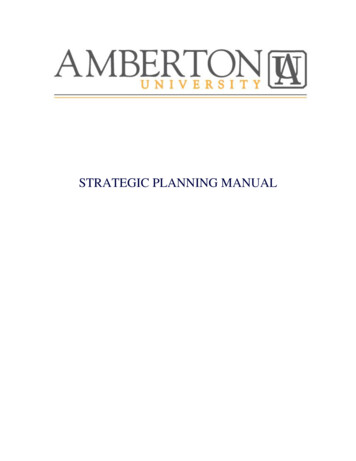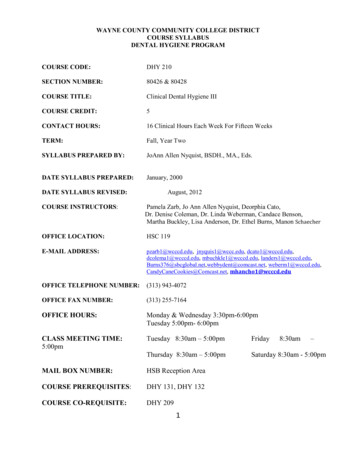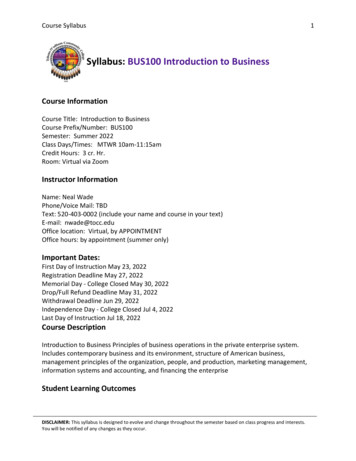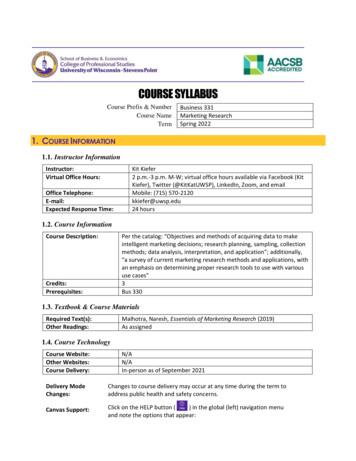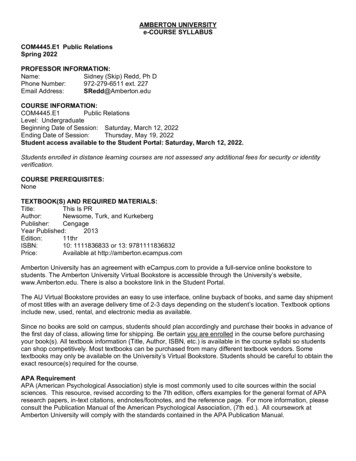
Transcription
AMBERTON UNIVERSITYe-COURSE SYLLABUSCOM4445.E1 Public RelationsSpring 2022PROFESSOR INFORMATION:Name:Sidney (Skip) Redd, Ph DPhone Number:972-279-6511 ext. 227Email Address:SRedd@Amberton.eduCOURSE INFORMATION:COM4445.E1Public RelationsLevel: UndergraduateBeginning Date of Session: Saturday, March 12, 2022Ending Date of Session:Thursday, May 19, 2022Student access available to the Student Portal: Saturday, March 12, 2022.Students enrolled in distance learning courses are not assessed any additional fees for security or identityverification.COURSE PREREQUISITES:NoneTEXTBOOK(S) AND REQUIRED MATERIALS:Title:This Is PRAuthor:Newsome, Turk, and KurkebergPublisher:CengageYear Published:2013Edition:11thrISBN:10: 1111836833 or 13: 9781111836832Price:Available at http://amberton.ecampus.comAmberton University has an agreement with eCampus.com to provide a full-service online bookstore tostudents. The Amberton University Virtual Bookstore is accessible through the University’s website,www.Amberton.edu. There is also a bookstore link in the Student Portal.The AU Virtual Bookstore provides an easy to use interface, online buyback of books, and same day shipmentof most titles with an average delivery time of 2-3 days depending on the student’s location. Textbook optionsinclude new, used, rental, and electronic media as available.Since no books are sold on campus, students should plan accordingly and purchase their books in advance ofthe first day of class, allowing time for shipping. Be certain you are enrolled in the course before purchasingyour book(s). All textbook information (Title, Author, ISBN, etc.) is available in the course syllabi so studentscan shop competitively. Most textbooks can be purchased from many different textbook vendors. Sometextbooks may only be available on the University’s Virtual Bookstore. Students should be careful to obtain theexact resource(s) required for the course.APA RequirementAPA (American Psychological Association) style is most commonly used to cite sources within the socialsciences. This resource, revised according to the 7th edition, offers examples for the general format of APAresearch papers, in-text citations, endnotes/footnotes, and the reference page. For more information, pleaseconsult the Publication Manual of the American Psychological Association, (7th ed.). All coursework atAmberton University will comply with the standards contained in the APA Publication Manual.
The course presents issues related to the ways individuals and organizations represent themselves to theirrespective publics. Public relations is a communication function within the organization which influencesinternal and external audiences.UPON COMPLETION OF THE COURSE, THE STUDENT WILL BE COMPETENT IN:1. Defining public relations as a communication function within an organization.2. Describing the art and science of Public Relations.3. Listing and discussing the different kinds of PR research.4. Researching PR audiences and issues using technical and critical thinking skills.5. Identifying key issues that affect specific diverse audiences.6. Summarizing the legal, ethical, and moral considerations inherent in public relations.7. Discussing how management affects the public relations of a company.8. Listing and describing public relations tools.9. Listing and describing organizational publics such as government, media, internal publics, communitygroups, special interests, etc.10. Considering the values and opinions of the various publics when designing public relations positions andprograms that are persuasive.11. Discussing the role of Public Relations in government.12. Analyzing the effectiveness of the various media for influencing publics.13. Determining the advantages and disadvantages of the different types of media.14. Using effective business writing skills to compose a news release.15. Creating an effective radio announcement to influence a public.16. Using critical thinking skills to plan and to design a fund raising event.17. Analyzing a crisis and developing a message which would build the image of an organization of a person.18. Determining the goal, the theme, and the media for a persuasive campaign.19. Developing a code of ethics to guide a PR career.COURSE POLICIES:1. If an assignment is late, you will lose 5 points for the first 6 days, 10 points on the 7th day, 20 pointson the 14th day. No assignment will be accepted after two weeks.2. The presentation must be presented by video in order for you to get credit3. The assignment must be submitted in Moodle and as a word.doc and able to be opened in order for itto be considered on time. The assignment must be to be on time.4. Please label your assignments EXACTLY this way: last name, first name, course number, assignmentnumber, i.e., SmithJaneCom6420ex1.5. Please check the announcements in Moodle and Professor’s Comments for updates on the course.Incompletes are rarely given, (stay current with the course material and assignments).Student’s ResponsibilitiesThis syllabus contains information, policies and procedures for a specific course. By enrolling, the studentagrees to read, understand and abide by the policies, rules, regulations, and ethical standards of AmbertonUniversity as contained in the current university catalog and schedule of classes.Attendance Policy:Regular and punctual class attendance and engagement is expected at Amberton University. In case of anabsence, it is the student’s responsibility to contact the professor as soon as possible. If a student intends onwithdrawing from a course, it is the student’s responsibility to follow the university’s policy on formallywithdrawing from a course. Ceasing to attend classes does not constitute an official withdrawal.Attendance in a lecture course is defined as punctual arrival to, and engagement in, a full lecture session.Attendance in a distance learning course is defined as active participation in the weekly online class sessions.“Active participation” can be defined as: submitting an academic assignment, taking an exam, engaging in aninteractive tutorial, participating in an online discussion forum (or chat session), or initiating (or responding to) acommunication with a faculty member about an academic assignment or the subject matter of the course. Astudent not meeting these requirements may be dropped at the discretion of Amberton University.
Plagiarism PolicyPlagiarism is the presentation of someone else’s work as though it were your own. If you use another person’swords, ideas, or information, or if you use material from a source – whether a book, magazine, newspaper,business publication, broadcast, speech, or electronic media – you must acknowledge the source. Plagiarismis a violation of the University’s code of student ethical conduct and is one that is taken seriously. AmbertonUniversity operates on an honor system; therefore, honesty and integrity are essential characteristics of all whoare associated with the institution. All Amberton University students are expected to abide by the honorsystem and maintain academic integrity in all their work. Amberton University and its instructors monitorstudent work for plagiarism and reserve the right to submit such work to technology-based anti-plagiarismservices and applications at any time.Students agree that by taking this course, all required papers may be subject to submission for textualsimilarity review to TurnItIn.com for the detection of plagiarism. All submitted papers will be included as sourcedocuments in the TurnItIn.com reference database solely for the purpose of detecting plagiarism in suchpapers. Use of TurnItIn.com service is subject to the Usage Policy posted on the TurnItIn.com site.COURSE OUTLINE AND CALENDAR:The course is comprised of lecture, case studies, presentations, and a project. You will also have a midtermand final which will be taken in Moodle.WeekTopicAssignment1 March 12IntroductionResearch2 March 19The Publics3 March 26The Media4 April 2Tactics andTechniquesCampaigns5 April 9Theories6 April 16Crisis7 April 23EthicsThe LawChapter 1 PR Rolesand ResponsibilitiesChapter 2 PR’sOrigins andEvolutionChapter 3Research: Planning,Processes andTechniquesChapter 4 Publicsand Public OpinionChapter 9CommunicationChannels andMediaChapter 10 Tacticsand TechniquesThat Make PRStrategyChapter 11CampaignsChapter 5TheoreticalUnderpinnings forPRChapter 12 Crisisand CredibilityChapter 6 PREthics andResponsibilities8 April 30The PRpresentationChapter 7 PR andthe LawCompetenciesCovered1, 2, 3, 4Due Date8, 9, 10, 114, 5, 9, 134, 5, 9, 13Chapters 1, 2, 3, 4,9, 10, 11 Mid TermDue in Moodle –Friday, April 8th14, 15, 164, 8, 12, 14, 166, 7, 11, 2018Critiques CrisisPresentations duein Moodle – Friday,April 29thPR Projects due inMoodle – Friday,
9 May 7StrategicManagement10 May 14ReviewGRADING CRITERIA:MidtermFinalCrisis Presentations EvaluationsProject Assignment PaperProject Assignment PresentationTotalChapter 8 StrategicManagement in PRPractice4, 17, 18AllMay 6thPresentationsvideos due inMoodle – Friday,May 13thChapters 5, 6, 7, 8,12 Final Due inMoodle – Tuesday,May 17th100 pts100 pts25 pts150 pts125 pts500 ptsUndergraduate90 – 100A80 – 89B70 – 79C60 – 69DBelow 60FGRADE NOTIFICATION AND INSTRUCTOR FEEDBACK:A successful distance learning experience requires a flow of communication between instructor and studentthroughout the session. Instructor comments are considered essential to the learning process. Therefore,each assignment/exam submitted will be reviewed, graded and returned to the student in a timely manneralong with the appropriate commentary. Students should carefully review all comments.Final grades are processed approximately one week after the last day of the session and may be located in theMy Grades section of the online registration portal as well as being emailed to the student’s AmbertonUniversity email. Amberton University staff will not release grades over the phone. University instructors willnot leave a message with comments or grades in any type of media that is not secure.For questions regarding grades after the semester has ended, students should use their university emailaccount and contact the instructor at the faculty email address as provided above in Professor Informationarea.Incomplete GradesAn “I” (incomplete grade) is given at the discretion of the professor and may be given only when an emergencyor illness prevents the student from completing course requirements. Should an “I” be granted, the student has30 days from the end of the session to complete the conditions of the incomplete. An “I” which is not properlyremoved within 30 days following the session enrolled will become an “F” grade.How To Withdraw From a CourseTo be official, the class withdrawal must be in writing and signed by the student requesting the withdrawal; nowithdrawal is accepted verbally. Please review the “Schedule of Classes” (online or in-print) for procedures forclass changes or withdrawals and the refund policy and schedule.COURSE DELIVERY METHODOLOGY:This course is offered as a distance-learning course through the Moodle Learning Platform. Amberton’sdistance learning courses, called e-Courses, are identical to classroom courses in terms of learning outcomes,competencies, and instructor expectations. A student choosing to take an e-Course must have the followingskills and technical capabilities:
1. Access to the Internet2. General knowledge in:Internet browser settings and configuratione-mail and file attachmentsUploading and downloading filesUsing a word processing package3. Ability to conduct on-line researchStudents who have not mastered these skills should not enroll for this course, but should consider enrolling inMIS2110 Computer Concepts and Internet Technologies for instruction in these areas.HOW TO ACCESS YOUR COURSE:Through the Amberton University Student PortalStudents enrolled in distance learning courses using the Moodle Learning Platform may access the coursethrough the Amberton University Student Portal. The site may be accessed through the University’s mainpage (http://www.Amberton.edu) or at http://apps.Amberton.edu. After selecting the “Student Portal” link,you will be prompted for a Username and Password.Use your assigned username and password (AUID) as described below to enter the AU Student Portal:Username your capitalized firstname initial lastname last 3 digits of your SSN.* Use your name exactly as it is listed on the University’s records, including any suffixes orhyphenations, such as Jr, Sr, or II, as a part of your username.For example: James Jones, Jr.Username: JJonesJr789SSN: 123-45-6789Password your Amberton University ID# (AUID) including the dashesFor example: 04-999-999Once your login has been validated, you may select from a variety of menu options, including yourindividual E-Course, email account, Remote Research, General Tools, all Syllabi, Research Tutorials andElectronic Instructor Folders (FTP).If you are accessing the Student Portal from a public or shared computer, close the browser completelywhen finished, or click on the Logout button. For security purposes, no other person should have access toyour Username or Password. If you feel your information has been compromised or if you experiencetechnical difficulties, contact the e-course system administrator at: e-sysop@amberton.eduIf you have lost or do not know your Amberton ID#, please contact the Student Services Office 972/2796511 or advisor@Amberton.edu for a replacement AUID card. You must know your Amberton ID# to gainaccess to the course and to send email to your professor.Through the Amberton University Moodle WebsiteStudents enrolled in distance learning courses using the Moodle Learning Platform may also access thecourse by going to: http://moodle.Amberton.eduFor those utilizing Moodle for the first time, the username and password for the Moodle Learning Platformwill be emailed to the student’s University email account prior to the start of the course. For those returningto Moodle who do not remember their username and password, click on the link “Forgotten your usernameor password” available on the Moodle log in page (http://moodle.Amberton.edu). Otherwise use the sameusername and password as previous session.
Moodle Tutorial:Upon successful log in and access to the Moodle learning platform, there is a Student Moodle Tutorials courseavailable, to learn about the basics of Moodle. Simply click on the link for the Student Moodle Tutorials andread through the various learning topics: Navigating; Communicating; Assignments & Exams; Grades; andStudent Resources.COURSE COMMUNICATIONS:Students will communicate with faculty through the Moodle Learning Platform or the Amberton University emailsystem.Each student enrolled is assigned an Amberton email account, which gives the student access to theAmberton email system (my.Amberton.edu). This email account is provided by Google Apps for Education.Students are encouraged to check their email regularly for University news, notices, and to communicate withinstructors.The student’s assigned email address would be Username@my.Amberton.eduExample: LJones-Smith789@my.Amberton.eduThe student Username is determined by:firstname initial lastname last 3 digits of student ssn.For example: Linda Jones-SmithSSN: 123-45-6789Email Address LJones-Smith789@my.Amberton.eduStudents will be prompted for a Username and Password when accessing their email account. Use theUsername portion of the email address as the username (Example: LJones-Smith789) and your Amberton ID#(including the dashes) as the password.If you already have a Google gmail account, you might be prompted to add this account to your currentaccount. Click ‘Yes’ and you will be logged into your my.Amberton.edu email account. It will be a separateemail account from your personal gmail account.If you need assistance with your email account, please visit https://support.google.com/mailStudents are responsible for reviewing the “Communication Guidelines” provided on the individual ECourse for specific instructor requirements.Upon completion of a session, all communication and course specific information is removed from the Moodlesystem. If a student needs to maintain a record of communications or assignments, the student is stronglyencouraged to print out or download these items to a disk for their own records.FORMAT AND SUBMISSION OF ASSIGNMENTS:Assignments are to be submitted to the appropriate assignment Drop Box in the Moodle system. Specificdirections and guidelines for submission of assignments are located on-line in the “Communication Guidelines”of the e-course. Due to compatibility issues, Office 2007 files cannot be read by earlier versions of MicrosoftOffice. Before submitting an exercise file, confirm the file is in the proper format for grading by the instructor.INSTRUCTOR/COURSE EVALUATION:Each session, all Amberton students are provided with the opportunity to evaluate their courses andinstructors. The evaluation process is an important one and provides students with an anonymous andconfidential way to give meaningful feedback to the University. Summary information and comments areprovided to faculty after the close of the session. All information provided is anonymous.The Instructor/Course Evaluation will be open for completion during week 9 of the session. An evaluationassignment will be placed in week 9 of the Moodle course, along with the instructions on how to complete the
evaluation. Prior to week 9, the University will send out an email containing instructions and dates for theevaluation period.RESEARCH RESOURCES:The Library provides access to full-text, and peer reviewed articles, and digital research tools. Students cansearch Library holdings through the online catalog and databases search engines available on the Librarywebsite or browse the physical library space and holdings located at the Garland campus.Research items not contained in the Amberton Library collection can be located through interlibrary Loan (ILL)or through the TexShare program with the help of the Library staff. Students with questions about availableservices, resources, or research, may contact the Library via email at Library@amberton.edu.RESEARCH ACCESS:Databases can only be accessed by authorized users, and students at Amberton must enter their Amberton IDcredentials-same as Moodle login-to gain access when off-campus. Use an Amberton website, such as theUniversity site (Amberton.edu) or the library site (Library.amberton.edu) to find links to databased and digitalbooks. Online resources are available all day, every day.Library Live Chat FeatureLibrary staff are available to assist students with research problems or questions during Library hours througha live online chat feature, telephone, email, “How-to” videos, or in person. The Library telephone is (972-2796511 ext. 136, 137, or 138. You can email questions to library@amberton.edu or visit the Library in person onthe Garland campus for assistance.
e-COURSE SYLLABUS . COM4445.E1 Public Relations . Spring 2022 . PROFESSOR INFORMATION: Name: Sidney (Skip) Redd, Ph D . Phone Number: 972-279-6511 ext. 227 . Email Address: . Defining public relations as a communication function w ithin an organization. 2. Describing the art and science of Public Relations.




